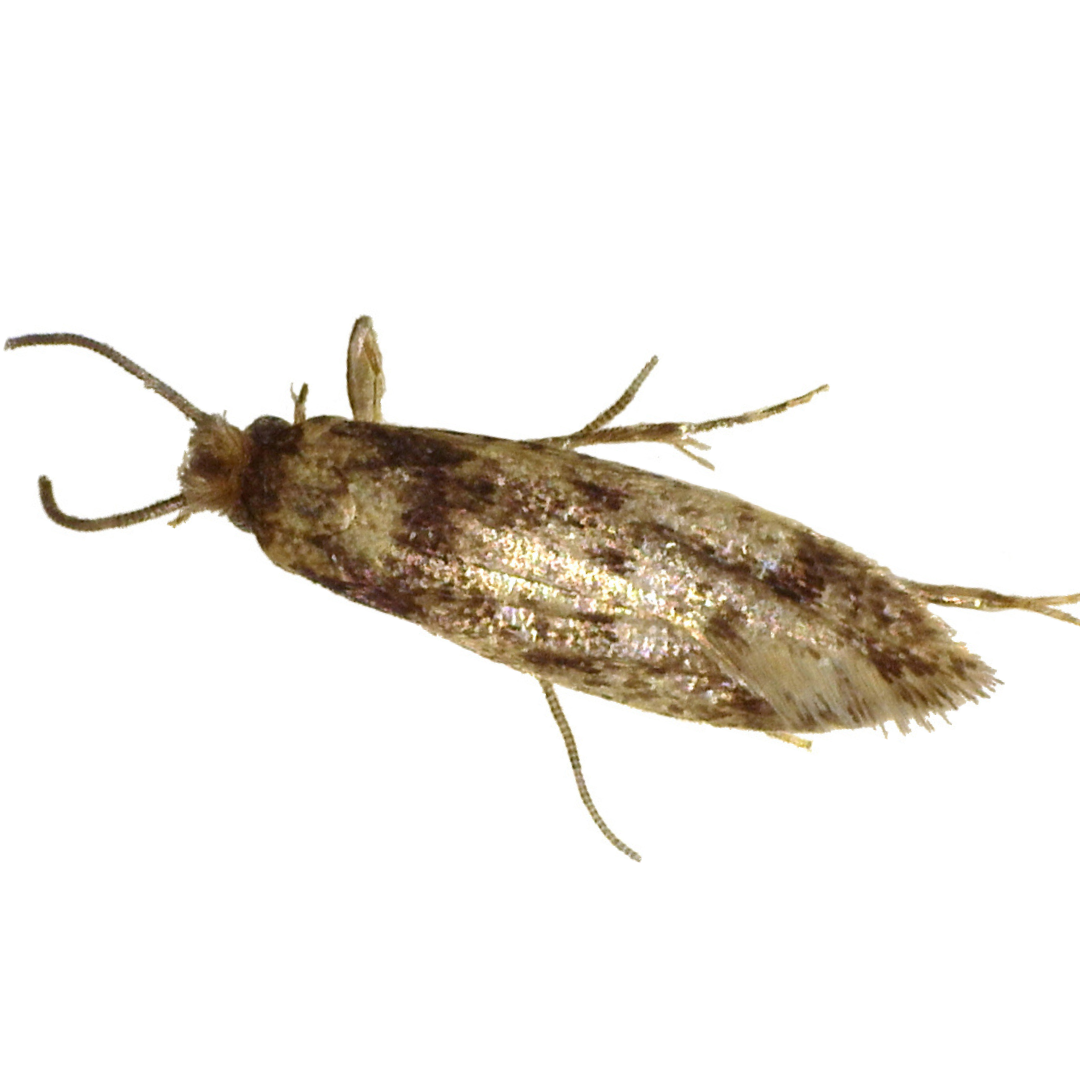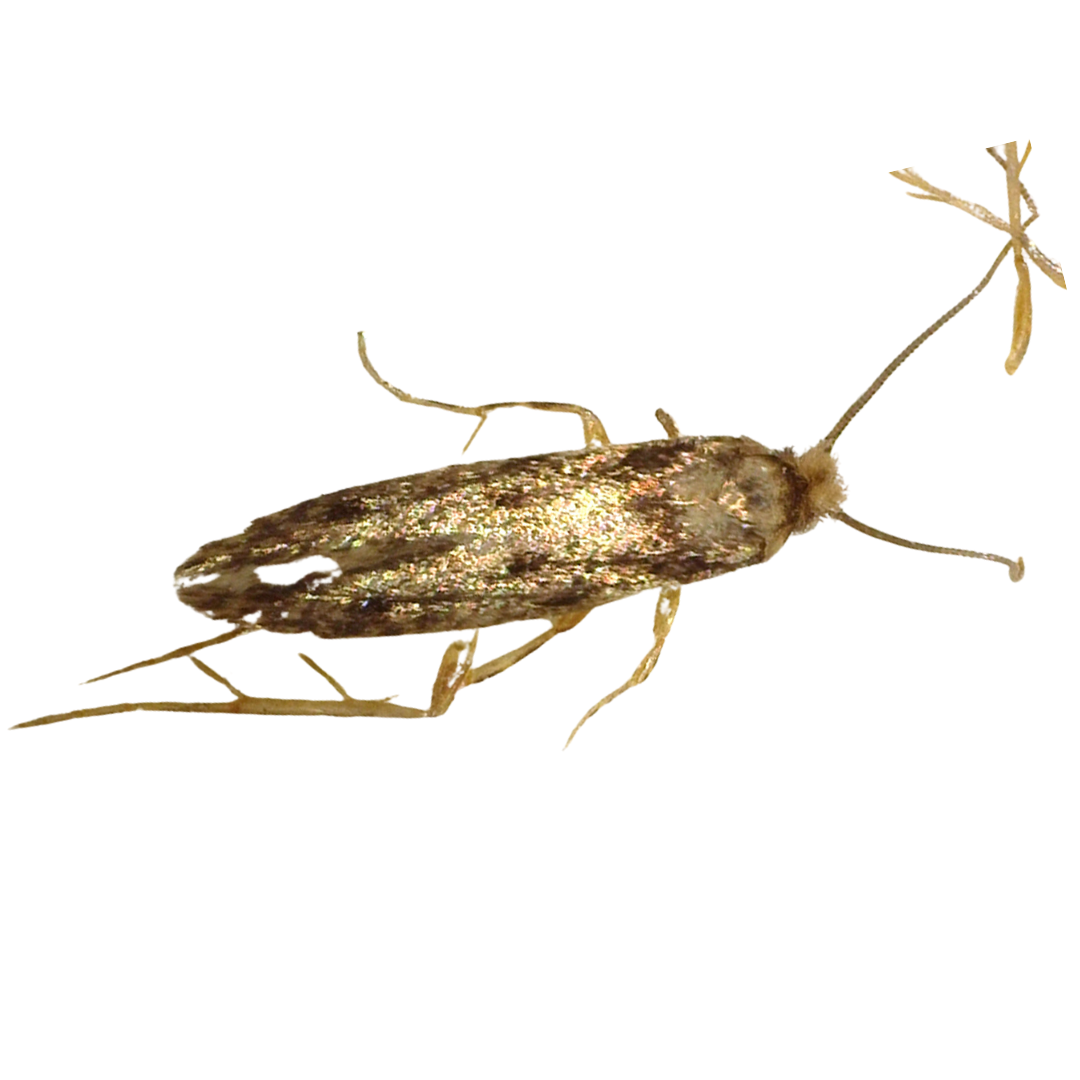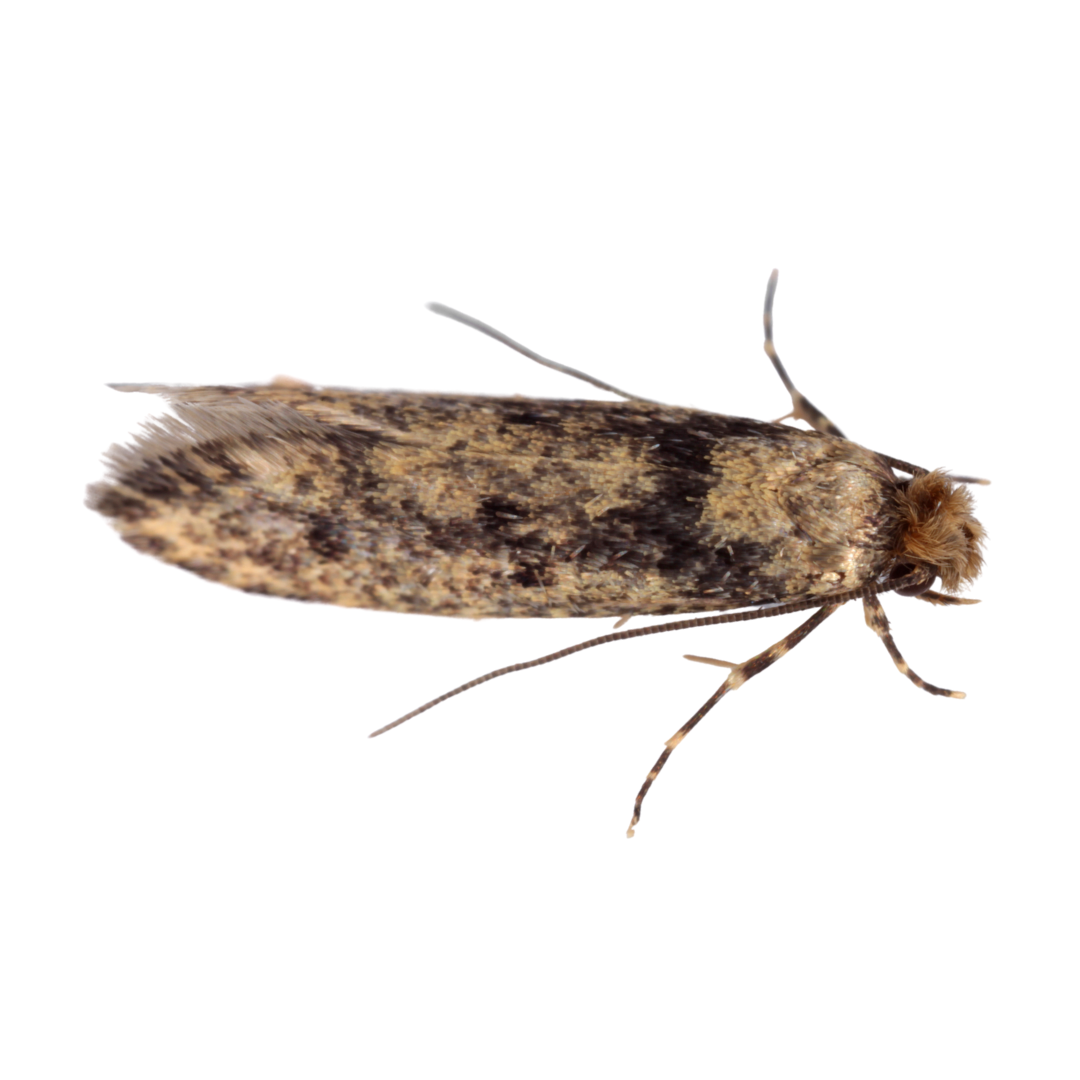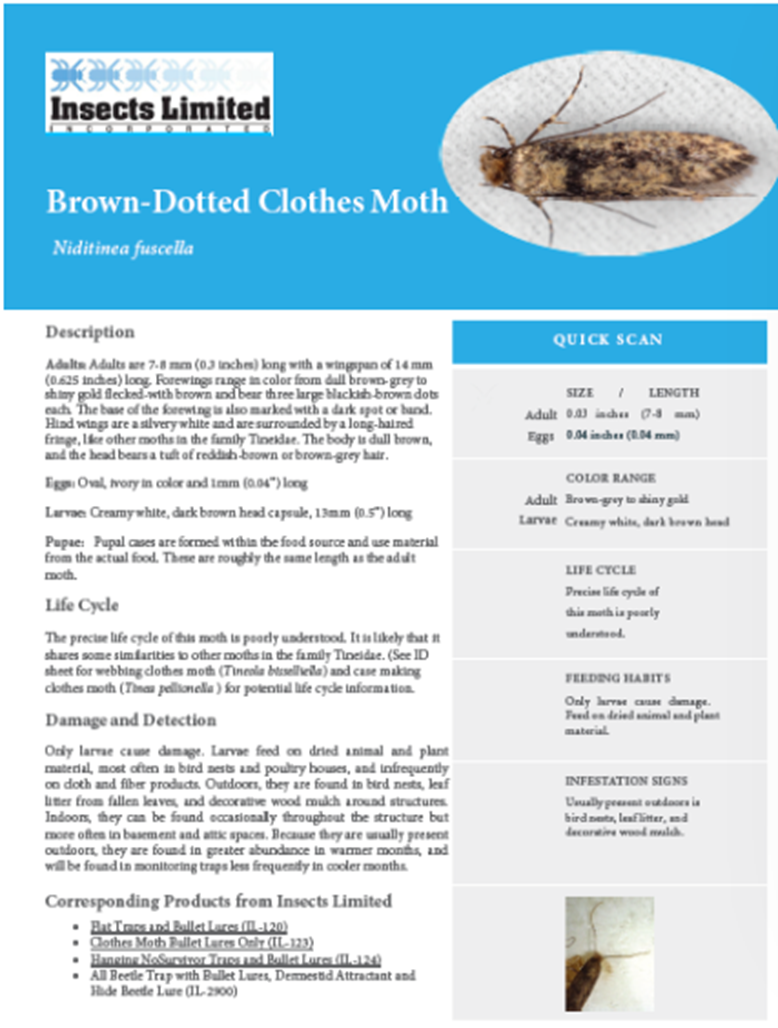Brown-Dotted Clothes Moth (Niditinea fuscella)



Pheromone Traps for Brown-Dotted Clothes Moth
Brown-Dotted Clothes Moth Description
Brown-Dotted Clothes Moth Adults: Adults are 7-8 mm (0.3 inches) long with a wingspan of 14 mm (0.625 inches) long. Forewings range in color from dull brown-grey to shiny gold flecked-with brown and bear three large blackish-brown dots each.
The base of the forewing is also marked with a dark spot or band. Hind wings are a silvery white and are surrounded by a long-haired fringe, like other moths in the family Tineidae. The body is dull brown, and the head bears a tuft of reddish-brown or brown-grey hair.
Brown-Dotted Clothes Moth Eggs: Oval, ivory in color and 1mm (0.04”) long
Brown-Dotted Clothes Moth Larvae: Creamy white, dark brown head capsule, 13mm (0.5”) long
Brown-Dotted Clothes Moth Pupae: Pupal cases are formed within the food source and use material from the actual food. These are roughly the same length as the adult moth.
Brown-Dotted Clothes Moth Life Cycle
The precise life cycle of this moth is poorly understood. It is likely that it shares some similarities to other moths in the family Tineidae. (See Insect Monitoring Guidelines for webbing clothes moth (Tineola bisselliella) and casemaking clothes moth (Tinea pellionella ) for potential life cycle information.
Damage & Detection
Only Brown-Dotted Clothes Moth larvae cause damage. Larvae feed on dried animal and plant material, most often in bird nests and poultry houses, and infrequently on cloth and fiber products.
Outdoors, they are found in bird nests, leaf litter from fallen leaves, and decorative wood mulch around structures. Indoors, they can be found occasionally throughout the structure but more often in basement and attic spaces.
Because they are usually present outdoors, they are found in greater abundance in warmer months, and will be found in monitoring traps less frequently in cooler months.
Fun Facts about the Brown-Dotted Clothes Moth
Similar species include Webbing clothes moth (Tineola bisselliella) and Casemaking clothes moth (Tinea pellionella).
Other common names include European house moth, poultry house moth, and common clothes moth.
Like many clothes moth species, adult Brown-dotted clothes moths do not eat. Their larvae are vivacious feeders and damage natural fibers, fungus, and stored products.
Brown-dotted clothes moths initiate flight at temperatures above 12.5°C (55°F).
The pheromone that attracts brown-dotted clothes moths also attracts other moth species including:
Webbing clothes moth (Tineola bisselliella)
Casemaking clothes moth (Tinea pellionella)
Monitoring Tips & Tricks
Brown-Dotted Clothes Moth Monitoring Guidelines
Lure
Clothes Moth BULLET LURE® is the recommended lure to use when monitoring for this insect. It contains sex pheromone to attract male moths.
Lure Storage
Keep unopened lures in cool storage less than 16°C (60°F) or place in the freezer for extended storage. Lures can remain frozen for up to 24 months or at room temperature for 12 months to retain their full effectiveness for use afterwards.
Trap Designs Used with Lure
FLAT TRAPS are a low-profile sticky trap which are another option that should be placed on a flat surface when a hanging trap is not preferred by customers.
NOSURVIVOR traps are diamond shaped sticky traps that can be hung from many locations.
THE ALL BEETLE TRAP is a low profile, 3 piece trap with a clear lid that should be placed on level surfaces.
Brown-Dotted Clothes Moth Pheromone Traps
Trap Placement & Use
Trap Placement Techniques
Pheromone traps can be placed out year-round but are especially recommended during warmer months when temperatures exceed 12.5°C (55°F).
Place hanging pheromone traps 1.5 m (5 feet) above ground or at eye level to allow for easy inspection when monitoring traps. In areas such as a closet or home, place one or two pheromone traps per room.
In commercial areas such as warehouses or museums, place pheromone traps 7.5–15 m (25–50 feet) apart to determine the presence or absence of Brown-dotted clothes moths.
Increase pheromone trap density to 4.5–7.5 m (15–25 feet) apart to help locate the source of Brown-dotted clothes moth. Keep pheromone traps 7.5 m (25 feet) away from exterior doors.
Brown-dotted clothes moths pheromone traps are best utilized in areas that store items that contain natural fibers and stored foods such as wool, hair, feathers, furs, upholstered furniture (containing natural wools and leathers), food, grains, seeds, spices, nuts, dried fruit, animal feed, or pet food.
Trap and Lure Maintenance
Replace traps when glue is filled with insects or becomes dusty. Replace pheromone lures every 90 days. Replace all pheromone lures in a location at the same time.
Do not cut the cap off the bullet lure. Do not stagger lure replacement over several weeks. Record date and number of catches to identify trending information.
Brown-Dotted Clothes Moth FAQs
What do brown-dotted clothes moths look like?
Adult brown-dotted clothes moths are 7-8 mm (0.3 inches) long with a wingspan of 14 mm (0.625 inches) long. Their forewings range in color from dull brown-grey to shiny gold flecked-with brown and bear three large blackish-brown dots each.
The base of the forewing is also marked with a dark spot or band. Hind wings are a silvery white and are surrounded by a long-haired fringe, like other moths in the family Tineidae. The body is dull brown, and the head bears a tuft of reddish-brown or brown-grey hair. Their eggs are oval in shape and ivory in color and 1mm (0.04”) long.
Brown-Dotted Clothes Moth larvae are creamy white, dark brown head capsule, 13mm (0.5”) long. The pupal cases are formed within the food source and use material from the actual food. These are roughly the same length as the adult moth.
What is the life cycle of the brown-dotted clothes moth?
The precise life cycle of this moth is poorly understood. It is likely that it shares some similarities to other moths in the family Tineidae. (See Insect Monitoring Guidelines for webbing clothes moth (Tineola bisselliella) and casemaking clothes moth (Tinea pellionella ) for potential life cycle information.
How to get rid of clothes moths?
The first step for how to get rid of clothes moths is determining where the clothes moth infestation is originating from. This is best done by using clothing moth pheromone traps. Pheromone traps placed closest to clothing moth infestations will capture more moths.
By checking and comparing traps, one can determine if the source is coming from a certain area, room or closet. The ability to narrow down the source of the infestation allows the user to visually identify individual objects, clothing or rugs that are a breeding food source for clothes moths.
Once these items are located, an extermination method can be determined that will answer the question: How to kill clothes moths? The answer to this question is typically achieved through bagging and freezing smaller objects for several days. Some items can be run through the hottest cycle in a clothes dryer for a full 60 minutes.
Larger items, such as wool rugs can be taken outdoors and beaten to dislodge any moth adults, larvae and eggs. Steam cleaning or chemical treatments can also kill moths on carpets or on furniture that contains natural animal fibers.
Join Our Informed Community
Receive the latest industry updates as soon as they are published.




